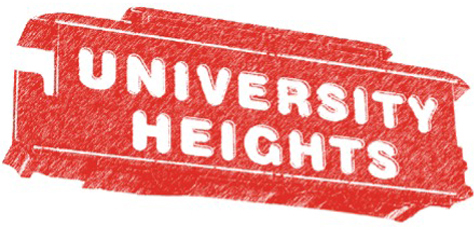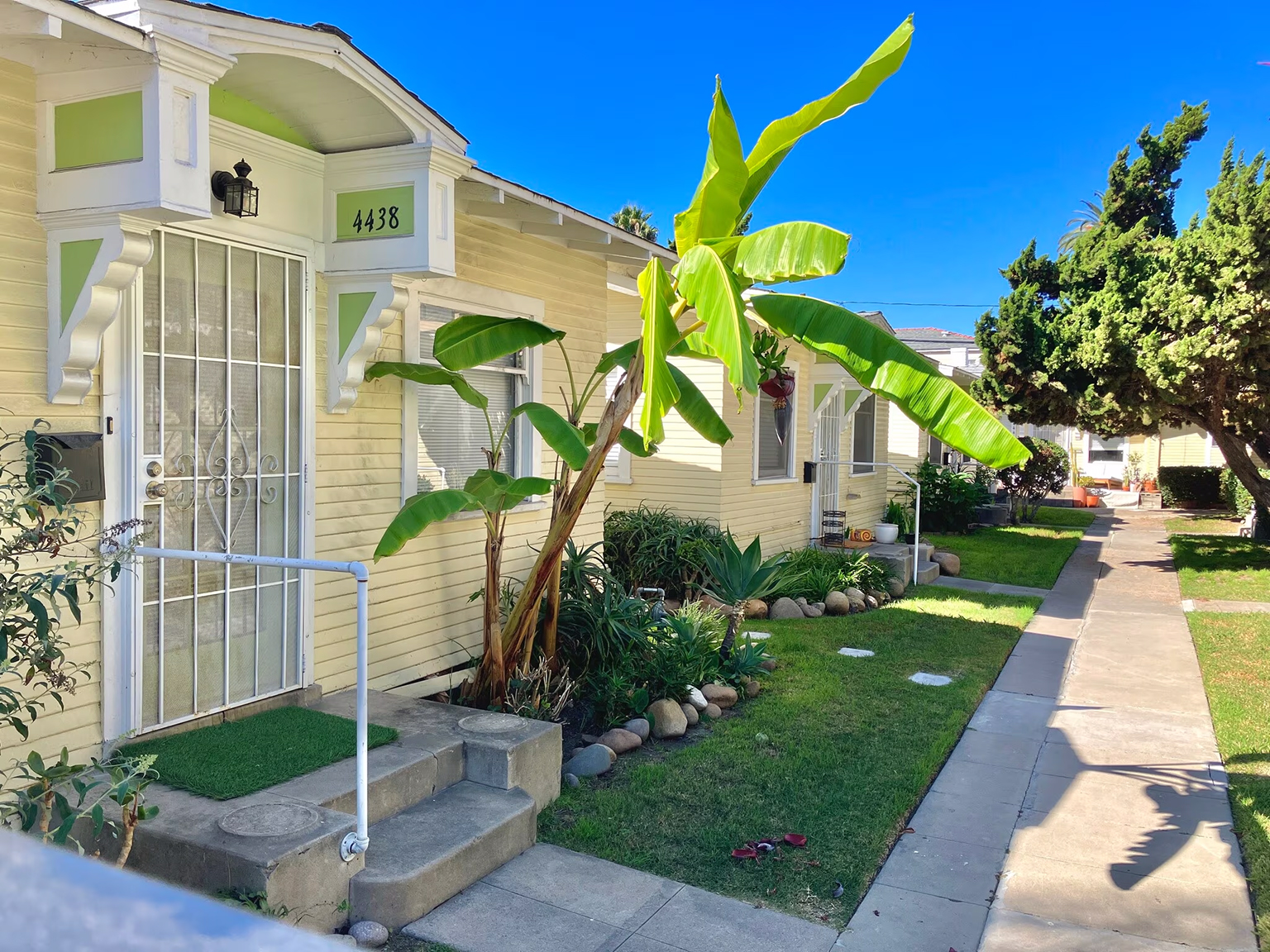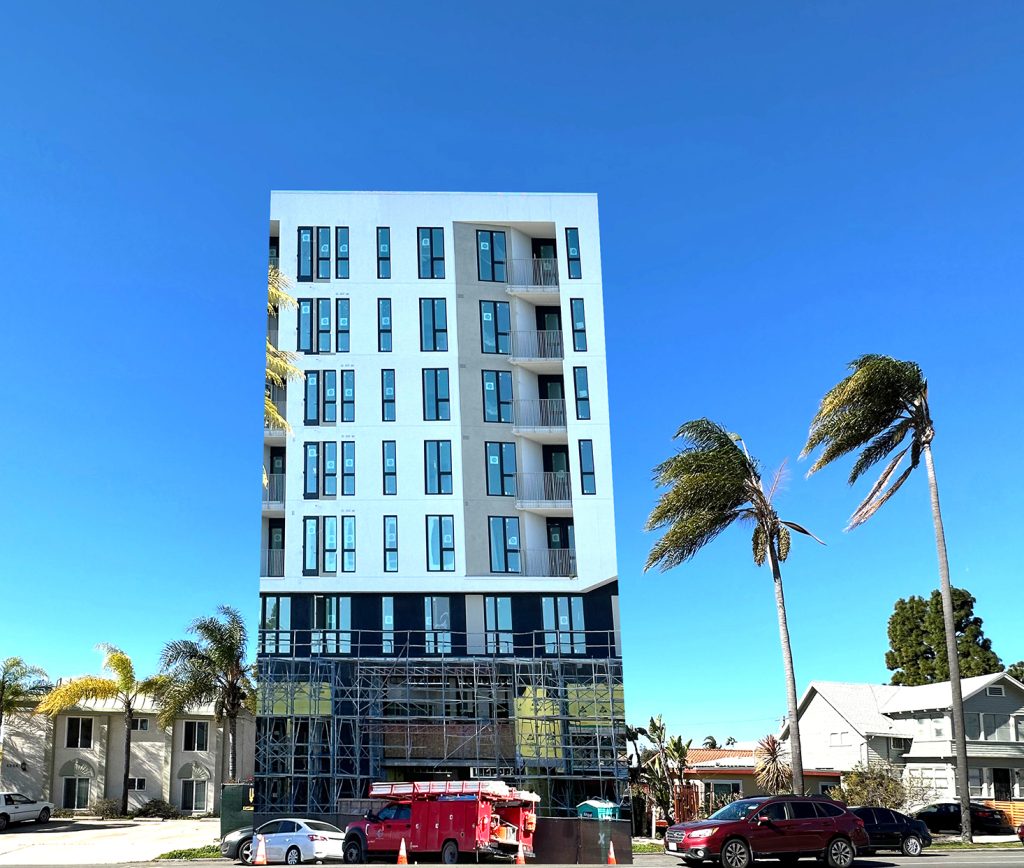Bungalow Court For Sale at 4438 Park Blvd. Described on LoopNet website as "high density Complete Communities Tier 2 overlay with an 8.0 FAR allows for significant development potential of potentially 50+ units."
As we approach the primary and general election for Mayor and the District 3 Council seat, residents of University Heights and other neighborhoods throughout San Diego may be concerned about the increasing proliferation of dense, tall buildings that circumvent approved zoning and community plans.
Some residents welcome it, and others are concerned about the growing costs to our neighborhoods including loss of historic resources and Naturally Occurring Affordable Housing (NOAH), displacement of current residents, reduced social equity, environmental impacts, added stress to inadequate, aging infrastructure, and reduced quality of life.
How Did We Get Here?
Starting in 2015, the City began incentivizing new building construction in North Park and Uptown through upzoning, municipal code changes, streamlining permit processes, eliminating project review by Community Planning Groups, and by offering height and density bonuses for projects within “Transit Priority Areas.”
In 2015, the City’s Climate Action Plan recommended “transit-oriented development” within ½ mile of transit stops as the crow flies to reduce vehicle miles traveled. The 2016 updates to the North Park and Uptown Community plans codified these goals by offering density bonuses for development within Transit Priority Areas (TPA).
In February 2023, the City Council (with the support of District 3 Councilmember Stephen Whitburn) approved a plan to expand the area for building incentives from within ½ mile of transit stops as the crow flies to 1 mile walking distance and renamed Transit Priority Areas to Sustainable Development Areas. Virtually all Normal Heights, North Park, and University Heights are now located within a Transit Priority Area (TPA) or Sustainable Development Area (SDA).
In 2016, the updates to the North Park and Uptown Community Plans (with the support of District 3 Councilmember Todd Gloria) allowed developers to build projects with significantly increased densities and building heights in the North Park and Uptown areas along major bus routes with only ministerial review and “suggested” design guidelines. An amendment to the Uptown Community Plan, called the Hillcrest Focused Plan Amendment, is currently in progress to increase the allowable number of units by at least 10,000 units within the Hillcrest area.
In December 2020, the Complete Communities Housing Solutions Regulations were added to the Municipal Code, under the leadership of Mayor Kevin Faulconer (and with the support of District 3 Councilmember Chris Ward). With only ministerial review, the Complete Communities program allows for the construction of multi-story buildings up to 10 floors without off-street parking within a Transit Priority Area (which includes virtually all Normal Heights, North Park, and University Heights) if the development includes the appropriate number of affordable units, and has an underlying zoning of at least 20 dwelling units per acre.
Several multi-story buildings in University Heights are either under construction or approved ministerially through the Complete Communities Program. These include the 5-story, 31 unit building at 4222 Georgia Street, and the 8-story, 49-unit building at 4350 Cleveland Avenue. As shown in this map, many neighborhoods throughout San Diego, including University Heights, North Park and Hillcrest, are eligible for the Complete Communities Program. That means multi-story buildings can be built with only ministerial approval on any parcel within these areas without community notification or input.
Another Complete Communities project underway in Hillcrest, the Quince Apartments at 301 Spruce Street, is a staggering 17 floors and 262 units, of which 22 will be affordable (12%).
Artist's Rendition of Proposed Complete Communities Project, 4350 Cleveland Avenue in University Heights. Source: Marc Johnson.
As of November 2023, over 60 Complete Communities projects throughout San Diego have either been approved, are in progress, or undergoing preliminary review with no community notification or input. Of the over 6,700 units either approved, in progress, or in preliminary review as of 11/23/23, only 13% are affordable.[i] Building permits may be tracked by address on the City of San Diego Development Services webpage.
What is the Purpose of All This Construction?
The goal of all this new construction is to fulfill the California Department of Housing and Community Development requirements for additional housing units as part of a state-mandated planning process called the Regional Housing Needs Assessment or RHNA. Of the total units required, over 60% are supposed to be deed-restricted units affordable to Very Low, Low, and Moderate Income households.[ii]
|
Income Level |
2021-2029 RHNA Goal |
2021-2022 Approved Housing Units |
% of RHNA Goal |
2010-2020 RHNA Goal |
2010-2020 New Housing Units |
% of RHNA Goal |
|
Extremely Low to Moderate |
64,199 |
1,145 |
1.8% |
54,148 |
7,549 |
13.9% |
|
Above Moderate |
43,837 |
9,202 |
21.0% |
33,954 |
41,208 |
121.4% |
|
TOTAL |
108,036 |
10,347 |
9.6% |
88,102 |
48,757 |
55.3% |
Source: City of San Diego Annual Report on Homes
As shown in the table above, RHNA required 88,102 additional housing units in San Diego during the last 10-year RHNA cycle from 2010 to 2020. Of these, 54,148 (61.5%) were to be affordable. During that time, only 7,549 affordable units were added in San Diego, representing 14% of the RHNA goal.
A new 8-year RHNA cycle began in 2021 with a goal of 108,036 additional units in San Diego by 2029. Of these, 64,199 are supposed to be affordable. So far in 2021 and 2022, a total of 1,145 affordable units have been added.
The City is relying largely on a private developer-driven strategy to add housing units, including affordable units. During the 2010-2020 RHNA cycle, this approach has resulted in an over-production of market-rate units, validating the public perception that the indiscriminate building is resulting in far more unaffordable units than affordable ones. A recent project, The Winslow, opened in University Heights with a one bedroom apartment renting for $3,000.
As explained above, the City is offering a variety of incentives to builders including density and height bonuses and waivers of parking requirements. While doing little to produce the needed affordable housing, these building incentives are causing destructive consequences in our neighborhoods including loss of historic resources and Naturally Occurring Affordable Housing (NOAH), displacement of existing residents, reduced social equity, environmental impacts, added stress to inadequate, aging infrastructure, and loss of quality of life.
An average of only 4,600 total units were built each year in 2021 and 2022. With the new RHNA requirement of 108,036 total units by 2029, approximately 14,000 units will need to be built each year from 2023 to 2029.
At the City’s current rate of adding 9% to 14% affordable units per year out of total units, only 10,000 to 15,000 affordable housing units will be built by 2029, falling significantly short of the RHNA goal of 64,199 affordable units. To reach the 64,199 affordable unit goal at the current ratio of affordable to total units, 64,000 to 100,000 total units would need to be built each year between 2023 and 2029!
In any of these scenarios, the over-production of units in buildings with excessive height and density will have serious consequences for our neighborhoods and our city.
The Myth of Trickle-Down Housing
Many housing advocates are saying loudly “build more and rents will come down.” As we have already seen in recent years, that is not what is happening in San Diego. The San Diego Union-Tribune reported in September 2023 that rents in the North Park/University Heights/Hillcrest/South Park area averaged $1,857 with an annual increase of 2.8%.
Other cities have also tried a “build more and housing costs will come down” approach without success. The Urban Institute released a study in March 2023 that concluded, “We find that reforms that loosen restrictions are associated with a statistically significant 0.8% increase in housing supply within three to nine years of reform passage, accounting for new and existing stock. This increase occurs predominantly for units at the higher end of the rent price distribution; we find no statistically significant evidence that additional lower-cost units became available or moderated in cost in the years following reforms.”
Patrick Condon, Chair of the Urban Design program at the University of British Columbia came to a clear conclusion after years advocating for increasing density in Vancouver, “unfortunately, in all the cases that I've examined throughout North America, what happens when you do a rezoning is you let the hungry dogs of land price speculation and inflation loose across the landscape with the intention of enhancing affordability.”
The Role of the Community Planning Groups
According to the City’s website, “The City Council adopted policies in the 1960s and 1970s that established and recognized community planning groups as formal mechanisms for community input in the land use decision-making processes. Community planning groups (CPG) provide citizens with an opportunity for involvement in advising the City Council, the Planning Commission, and other decision-makers on development projects, general or community plan amendments, rezonings and public facilities.”
Up until the North Park and Uptown Community Plan Updates of 2016, the North Park and Uptown Community Planning Groups fulfilled this mission by reviewing and providing input on proposed developments within these planning areas.
However, since those plan updates were adopted, the role of the community planning groups has been drastically reduced by the significant upzoning of both North Park and Uptown. In addition, municipal code changes like the Complete Communities Program and Housing Action Package override both zoning and community plans and require only ministerial review.
Developers are no longer required to even present their proposals for community input at Community Planning Group meetings. All these changes mean that the public only find out about new projects in their neighborhood when they are already under construction.
What Can Be Done?
There are no simple solutions to adding the required number of affordable housing but clearly, the City’s “build anything anywhere” policy is ineffective and unsustainable, and is causing a variety of negative consequences in our neighborhoods in the process. These include loss of historic resources and Naturally Occurring Affordable Housing (NOAH), displacement of current residents, reduced social equity, environmental impacts, added stress to inadequate, aging infrastructure, and loss of quality of life.
City housing policy has largely focused on simply increasing total housing supply without much consideration for these negative impacts.
In our opinion, the City can and should pause its ineffective, destructive housing policies, evaluate the success of its housing policies to date, gather more information, and create a broader set of metrics to guide land use decisions and evaluate building permits. These should include affordability, resident stability, cost-effectiveness, economic benefits, sustainability, diversity, and preservation of historic resources and Naturally Occurring Affordable Housing.
We also encourage residents to ask candidates for local office how they propose to address these complex issues. Simplistic solutions and empathy for the plight of our neighborhoods is not enough. We have an urgent need for City leaders with a vision and strategy for how to effectively add affordable housing in San Diego without creating more significant problems in the process.
[i] Public Record Request #23-6281, 11/7/2023
[ii] This article defines “affordable” as deed-restricted units affordable to Very Low, Low, and Moderate Income households.


